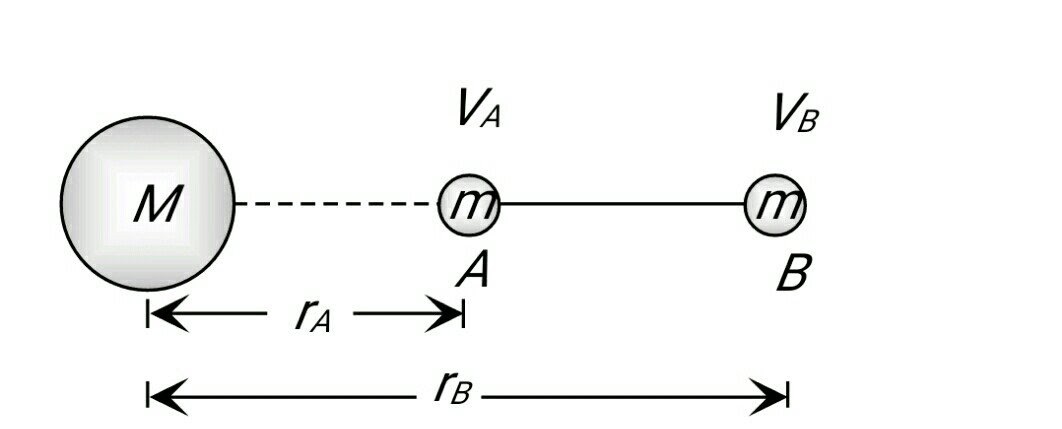Gravitational Potential - Practice Questions & MCQ
Quick Facts
-
Gravitational Potential due to Uniform solid sphere is considered one of the most asked concept.
-
28 Questions around this concept.
Solve by difficulty
Two bodies of masses $m$ and $4 m$ are placed at a distance r . The gravitational potential at a point on the line joining them where the gravitational field is zero is
Which of the following most closely depicts the correct variation of the gravitation potential V(r) due to a large planet of radius R and uniform mass density? (figures are not drawn to scale)
Concepts Covered - 5
In a gravitational field potential V at a point, P is defined as negative of work done per unit mass in changing the position of a test mass from some reference point to the given point.
Note-usually reference point is taken as infinity and potential at infinity is taken as Zero.
We know that
$
W=\int \vec{F} \cdot \overrightarrow{d r}
$
So $V=-\frac{W}{m}=-\int \frac{\vec{F} \cdot \overrightarrow{d r}}{m}$
And $\vec{I}=\frac{\vec{F}}{m}$
$
V=-\int \vec{I} \cdot \overrightarrow{d r}
$
$V \rightarrow$ Gravitational potential
$I \rightarrow$ Field Intensity
$d r \rightarrow$ small distance
We can also write
$
I=-\frac{d V}{d r}
$
Means a negative gradient of potential gives the intensity of the field.
The negative sign indicates that in the direction of intensity the potential decreases.
- It is a scalar quantity.
. Unit $\rightarrow$ Joule $/ \mathrm{kg}$ or $\mathrm{m}^2 / \mathrm{sec}^2$
- Dimension : $\left[M^0 L^2 T^{-2}\right]$
-
Gravitational Potential at a distance 'r'
If the field is produced by a point mass then
$
\begin{aligned}
& I=\frac{G M}{r^2} \\
& V=-\int \vec{I} \cdot \overrightarrow{d r} \\
& \text { So } \\
& V=-\frac{G M}{r}
\end{aligned}
$
at $r=\infty \quad V=0=V_{\max }$
-
Gravitational Potential difference
In the gravitational field, the work done to move a unit mass from one position to the other is known as Gravitational Potential difference.
If the point mass M is producing the field
Point A and B are shown in the figure.
=Gravitational potential at point A
=Gravitational potential at point B

$r_B \rightarrow$ the distance of mass at $B$
$r_A \rightarrow$ distance of mass at $A$
$\Delta V=$ The gravitational potential difference in bringing unit mass m from point A to point B in the gravitational field produced by $M$.
$
\begin{aligned}
& \Delta V=V_B-V_A=\frac{W_{A \rightarrow B}}{m} \\
& \Delta V=-G M\left[\frac{1}{r_B}-\frac{1}{r_A}\right]
\end{aligned}
$
-
Superposition of Gravitational potential
The net gravitational potential at a given point due to different point masses (M1,M2,M3…) can be calculated by doing a scalar sum of their individuals Gravitational potential.

$\begin{aligned} V & =V_1+V_2+V_3 \cdots \\ & =-\frac{G M_1}{r_1}-\frac{G M_2}{r_2}-\frac{G M_3}{r_3} \cdots \\ V & =-G \sum_{i=1}^{i=n} \frac{M_i}{r_i} \\ M_i & \rightarrow \text { mass } \\ r_i & \rightarrow \text { distances }\end{aligned}$
-
Point of zero potential
Let m1 and m2 are separated at a distance d from each other

And P is the point where net Gravitational potential $V=V_1+V_2=0$
Then P is the point of zero Gravitational potential
Let point $P$ is at distance $x$ from $m_1$
Then For point $P$
$
\begin{aligned}
& V=V_1+V_2=0 \\
& -\frac{G m_1}{r_1}-\frac{G m_2}{r_2}=0 \\
& -\frac{G m_1}{x}-\frac{G m_2}{d-x}=0 \\
& \quad x=\frac{m_1 d}{m_1-m_2}
\end{aligned}
$
For Uniform circular ring

$r=$ distance from ring
$a \rightarrow$ radius of Ring
$V \rightarrow$ Potential
At a point on its Axis
$
V=-\frac{G M}{\sqrt{a^2+r^2}}
$
At the center
$
V=-\frac{G M}{a}
$
For Uniform disc

$a \rightarrow$ Radius of disc
M-mass of disc
- At the center of the disc
$
V=-\frac{2 G M}{a}
$
- At a point on its axis
$
V=-\frac{2 G M}{a^2}\left(\sqrt{a^2+x^2}-x\right)
$
For Spherical shell

$R \rightarrow$ Radius of shell
$r \rightarrow$ distance from the center of the shell
- Inside the surface
$
\begin{aligned}
r & <R \\
V & =-\frac{G M}{R}
\end{aligned}
$
- on the surface
$
\begin{aligned}
r & =R \\
V & =-\frac{G M}{R}
\end{aligned}
$
- Outside the surface
$
\begin{aligned}
r & >R \\
V & =-\frac{G M}{r}
\end{aligned}
$
Uniform solid sphere

$R \rightarrow$ Radius of sphere
$M \rightarrow$ Mass of sphere
$r \rightarrow$ distance from the center of sphere
- Inside the surface
$
\begin{aligned}
r & <R \\
V & =-\frac{G M}{2 R}\left[3-\left(\frac{r}{R}\right)^2\right]
\end{aligned}
$
- on the surface
$
V_{\text {surface }}=-\frac{G M}{R}
$
- Outside the surface
$
V=-\frac{G M}{r}
$
- Tip-
$
\text { V centre }=\frac{3}{2} V \text { sur face }
$
Study it with Videos
"Stay in the loop. Receive exam news, study resources, and expert advice!"





